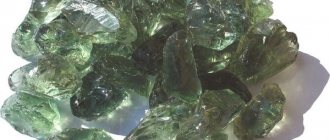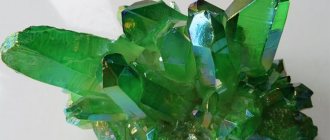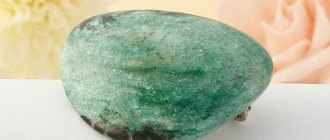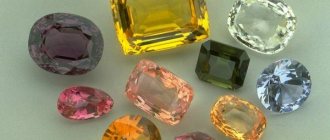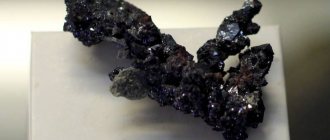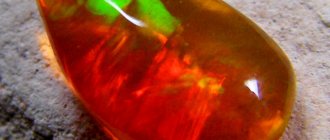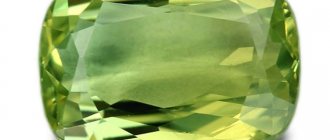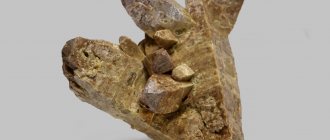Story
It is believed that the Greeks were the first to discover prasiolite. This happened more than 2500 years ago . The discoverers noticed that the intensity of the green color of the crystals depends on the sun: the brighter it shines, the paler the stone. The Greeks believed that it was the gods who painted the crystals, giving them magical properties.
In historical sources dating back to the ninth century BC, this stone is mentioned under the name prasitis. Later it was changed to prasiolite, translated from Greek as “leek-colored stone.” It is sometimes called "onion stone."
This mineral of a pleasant light green color is also known under other names:
- vermarine;
- peridine;
- green chrysoquartz;
- emerald or green quartz;
- Indian emerald.
Prasem - This term is applied not only to prasiolite, but also to any quartz that has an onion-green or grassy color.
Many centuries ago it was noticed that yellow and purple quartz could turn green when heated, like true prasiolite. Residents of the Urals baked yellow citrine into loaves of bread for this purpose.
Use in jewelry
In this part of our story we will touch on the jewelry moments in the life of the “onion stone”. Since the period when the name of the glorious King Montezuma sounded over the expanses of Mexico, and countless herds of bison grazed in its expanses, prasiolite has become an integral part of jewelry. At the same time, for many centuries, the cutting of the stone has remained the same and is performed as a cabochon. Thanks to this, the stone perfectly condenses sunlight, causing it to dance in its depths.
With an “onion stone”, silver earrings seem more elegant than with the same emerald or spinel. The silver ring will also look like Kramidan's "magic ice". A woman’s hand will be decorated with a bracelet made of this wonderful mineral, and her neck will be decorated with a pendant or necklace with this soft green gem.
Green amethyst or prasiolite: how to distinguish these stones from each other
There is still confusion in gemology regarding prasiolite: some experts consider it a green amethyst, others believe that it is simply a green variety of quartz.
The quartz group also includes amethyst, famous for its purple color.
The name “green amethyst” appeared in 1950 at the Montezuma mine in the Brazilian state of Minas Gerais. There, an artificial analogue of prasiolite was obtained by calcining amethyst at a temperature of 500 °C . The artificial stone turned out to be transparent and more durable than natural stone. Its color can be different shades of green.
The reason for this experiment was the following:
- Demand for green stones;
- Weak resistance of prasiolite to sunlight. When removed from the bowels of the Earth, it becomes discolored and becomes ordinary (colorless) quartz.
- Limited availability of natural prasiolite deposits.
- Relatively cheap material for producing artificial stone.
To create artificial prasiolite, the method of ionized irradiation is also used (it is used mainly in Africa).
There is another method: the stone is heated, then dipped into a cold dye solution. Thermal shock causes microcracks to appear in the mineral, into which pigment penetrates.
Color characteristics of natural and artificial prasiolite:
- The shades of the natural mineral are light green.
- The rich dark green color is characteristic mainly of stone processed at high temperatures.
To determine the naturalness of prasiolite, it is better to have it examined by a mineralogist who has the appropriate equipment.
In 1950, it was decided to consider prasiolite to be a type of quartz, and not to make a difference between natural and artificial stones.
Proponents of complete naturalness do not like this decision, but stone breeders accepted it with pleasure and began to reap the benefits of this compromise.
Physicochemical characteristics
Prasiolite is a rare variety of quartz. It has a range of green colors, rich in shades: from pale gray-green to grassy.
Sunlight can fade the color of the stone.
- Chemical formula - SiO2 .
- Color - onion green.
- The shine is glassy, pearlescent.
- Transparency - transparent or semi-transparent.
- Hardness - 7.
- Density - 2.65 g / cm3 .
The shape of the crystals is a hexagonal prism. The stone is quite fragile. Outwardly it resembles tourmaline, beryl, and peridot.
Prasiolite colors
Natural prasiolite usually has a light green tint. Brighter colors are characteristic of stones obtained in laboratory conditions. The following shades of this variety of quartz are distinguished:
- Onion green. It is believed that such samples have the most powerful magical effects. This color is classic and most popular.
- Green-yellow. A popular option that is rarely found among natural stones. It is important to consider that the mixture of yellow should not be too strong.
- Dark green and emerald. Such shades are most often obtained by processing amethyst. Sometimes there are representatives with a slight blue tint.
When exposed to sunlight for a long time, the mineral loses its color completely or partially. In this case, the loss of color often leads to a predominance of a gray tint.
Place of Birth
Prasiolite is rare in nature. Findings have been reported in:
- Canada;
- Brazil;
- USA;
- Namibia;
- Tanzania;
- Zambia;
- Poland.
Today, supplies are largely depleted, so most of the prasiolite on the market are artificial stones. Since 1950, they have been produced by heating amethyst and yellowish varieties of quartz from Brazil (Montezuma deposit) and the USA (Arizona) by at 500 °C
Methods for counterfeiting stone
The stone is counterfeited from amethyst, citrine or quartz, processing the mineral under high pressure and temperatures of more than 5000 Celsius, adding shades of yellow to it. There is also a method of processing stones using ion irradiation, which allows you to make a crystal clear green-yellow specimen, transparent with a glassy sheen. The third method is the cheapest for faking prasiolite - using dyeing. To do this, citrine is heated and dipped in paint, which gives it an external resemblance to the mineral.
Medicinal properties
Prasiolite, according to lithotherapists, has a certain healing power.
When using a stone for medicinal purposes, you should not refuse treatment prescribed by your doctor.
This stone is believed to have a positive effect on:
- heart and blood vessels;
- blood circulation;
- immune system;
- Airways;
- nervous system;
- emotional sphere;
- memory;
- ability for logical thinking.
Lithotherapists advise infusing water with prasiolite and drinking it when you have a cold, as it cleanses the airways and strengthens the immune system.
If you wash your face with this water, your skin will become more elastic and healthy.
Used for magic and medicinal purposes.
The stone has strong energy; psychics and magicians use it as a talisman that protects against outside influences.
Prasiolite is used in stone therapy, applied to a sore spot. It can cure cardiovascular diseases, relieve toothache, and help overcome mental pain. If you often wear jewelry with the mineral, it will give its owner spiritual strength and energy, and will also help relieve stress and depression.
The mineral can be processed; various jewelry is made from it, but the cost is very high.
- A ring with a processed stone attracts material well-being to the owner;
- A brooch or pendant attached at the level of the heart or solar plexus allows you to see through people and avoid betrayal;
- Earrings or head jewelry give clarity to their owner and help them find the right solution.
The mineral is considered a good store of energy, therefore it is used by healers to tune in to the wave of good luck, love, financial profit and is sold in the form of talismans, amulets, and amulets. It is also able to charge water, washing with which you can get rid of skin rashes and rejuvenate it.
Historical background: Catherine II wore a brooch with prasiolite, which allowed her to distinguish between friends and enemies among the majority of people around her.
Magic properties
Prasiolite was popular among the ancient Greeks: priests used it for initiation into the mysteries of existence, orators used it for the development of speech, imagination, and memory.
In ancient times, this mineral was used to protect against dark forces. It was believed that the cross into which this precious stone was inserted protected against bad thoughts and bad influence. They believed that through it a person’s connection with his guardian angel arises.
If prasiolite is to be used as a magical artifact, you need to choose a stone that has undergone the most gentle processing possible.
Previously, people believed that minerals from the quartz family are the astral shell of the Earth. Prasiolite was specially isolated from them, as they believed in its ability to absorb impulses and signals from the Universe. Some consider it a kind of recording device that accumulates information about our planet over millions of years.
With its help, experienced psychics can recognize the mysteries of the past, but inexperienced psychics, as well as magic lovers, are not recommended to use it in rituals and meditation, since the gem can confuse thoughts and stupefy the head, wishful thinking. Therefore, this mineral is sometimes called the “stone of illusions.”
If this mineral was stolen or taken by force, it will punish the criminal: he will soon develop a mental disorder and begin to hallucinate.
The magical properties of prasiolite are enhanced if it is set in platinum. Setting the stone in silver will bring good luck and prosperity.
Who is suitable according to their zodiac sign?
Prasiolite, as astrologers have found out, is suitable for all zodiac signs according to the horoscope, but it is ideally compatible with:
- Aries;
- Pisces;
- Sagittarius;
- Aquarius.
People born under these constellations will feel the positive effects of the gem:
- anxious thoughts will disappear;
- peace will appear;
- welfare will increase;
- the person will become more energetic and not subject to emotional stress.
A talisman or amulet made of prasiolite will also bring a lot of benefits to the rest of the zodiac signs. The magic of the stone will help people become more confident in their abilities and will contribute to spiritual development.
The main significance of prasiolite for a person is that he readily shares his positive energy.
Advice from astrologers
What do astrologers say?
If the opinion of astrologers is important to any of you, then they recommend wearing prasiolite to those born under the signs of Pisces, Aries, Sagittarius and Aquarius, although the stone will not counteract all other signs. They also claim that the gem attracts peace and tranquility into the home. Prasiolite stone is considered the guardian of the family. Author: Tatyana Dmitrieva
How to wear
When using prasiolite, you must adhere to the following rules:
- You cannot wear jewelry all the time: for a while you need to put it in a tightly closed box.
- Do not wear jewelry to the beach or for a walk on a sunny day - the stone may fade in the direct rays of the Sun.
- He also doesn’t like water, so when going to the pool, you need to take off your jewelry.
- Do the same before doing housework: the stone does not tolerate household chemicals.
If prasiolite is inherited, it cannot be given away as a gift, as its magical properties will be lost.
Jewelry with this gem is well suited for both casual wear and evening wear.
Jewelry with stone
The mineral is considered very valuable due to its rarity and fragility. Large specimens are practically never found.
Helpful information
It is believed that the magical properties of this stone are most pronounced when cut in silver. For this reason, this metal is the most sought after.
Green quartz is also often cut into yellow, rose or white gold. Prasiolite stone is often combined with artificial gems - cubic zirconia.
Care
Jewelry made from this material is not too difficult to care for. It is recommended to store them separately from other jewelry in a personal box. The following storage rules should also be observed:
- Avoid physical impact. Since the mineral is very sensitive and easily damaged, it must be worn carefully. Jewelry should be removed when playing sports and when doing household chores.
- Avoid exposure to chemicals and cosmetics. This often leads to uneven coloring and cracks.
- When cleaning the stone, do not use soap. Cleaning with a dry cloth or, if necessary, cold water is sufficient.
The main condition for storing and wearing prasiolite is the absence of prolonged contact with sunlight. Otherwise, the stone will quickly lose its appearance and it will be impossible to restore it.
Price
Stone obtained in laboratory conditions is noticeably cheaper than natural stone. The cost of natural minerals outside of jewelry starts from 3,000 rubles per 1 carat. The price of large samples varies from 40,000 to 250,000 rubles. It should be noted that prasiolites obtained by heating amethyst cost no more than 500 rubles per 1 carat.
How to distinguish from a fake
Stones of natural origin are used for inserts in premium-segment jewelry, which are not sold everywhere.
In jewelry stores you can buy jewelry with artificial prasiolite. This gem is an x-rayed or heated amethyst or citrine. It is not considered synthetic, as it has a natural base. These stones have colors to suit every taste: emerald, lemon green, mint.
Artificial mineral is more durable and resistant to fading. It can only be distinguished from natural ones using special equipment.
Both natural and artificial stone are beautiful. The color saturation of artificial is richer. Its price is lower (if the seller is honest).
Instead of a gemstone, they may also offer a fake made of glass. In your hands it heats up faster than stone.
Stone care
If jewelry with a stone is not worn constantly, then it should be placed in a special opaque case with soft upholstery so that the sun's rays do not penetrate and lighten it. Dusty jewelry can be dipped in a water solution with alcohol or soap, then rinsed with running water and dried on a paper towel. Wipe with a soft fleece cloth so as not to damage the surface of the prasiolite. It should be protected from falls, heat, and scratches.
Price
The cost of a product with prasiolite depends on:
- stone size;
- quality;
- cleanliness;
- frame material.
The price of a transparent natural stone with a cut is $30–115 per carat .
An artificial specimen costs $8–17 per carat .
Examples of prices in Russian online stores:
- tumbling (ennobled amethyst) 2–2.5 cm - 150 rub. for 1 piece ;
- earrings with ennobled amethyst— RUB 10,400. ;
- ring (red gold 585) — 17,950–35,950 rub.
